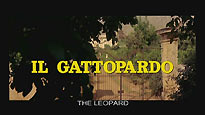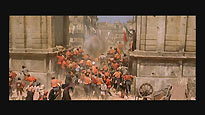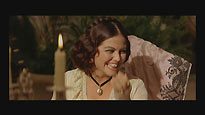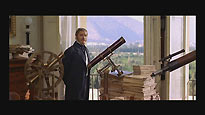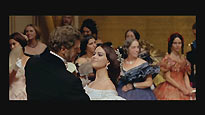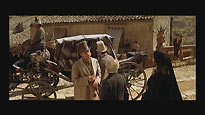|
THE LEOPARD Region 2 (UK) Edition reviewed by Mark Frost Director: Luchino ViscontiFeaturing: Burt Lancaster, Alain Delon, Claudia Cardinale1860. Sicily’s aristocracy, represented by the ageing Don Fabrizio - the Prince of Salina (Burt Lancaster), watch in dismay as they begin to lose their hold on money, power and influence to the rising middle classes. It is the time of the Regisorgimento – a social upheaval when the aristocracy was overturned by the lower classes to create a unified Italy. Don Fabrizio’s nephew, Tancredi (Alain Delon) leaves to fight for the rebels led by Garibaldi. The Prince sees a way to rescue his position by marrying his nephew to Angelica Sedara (Claudia Cardinale), the daughter of an ever more important nouveau riche figurehead in the new regime. Assured of his ongoing standing in the changing political climate, the Prince stands back to witness the passing of an era.
THE FILM Director Luchino Visconti was perfectly placed to tell this story. Even though he was publicly a socialist, Visconti came from a privileged background and must have been drawn to the novel for the parallels with his own life. To bring his alter ego to the screen, Visconti settled on Burt Lancaster. The American distributor insisted on having a US star to sell on its home soil. Lancaster is a superb actor, capable of displaying dignity, pathos and incredible inner strength. Visconti directs Lancaster to the performance of his career in The Leopard – using our pre-conceptions of the actors’ strength and physicality to show the Prince’s loss of power to maximum effect. Taken from the popular novel by Giuseppe Tomasi di Lampedusa, the film is often seen as the Italian Gone With The Wind. The Leopard is a much more complex story, with the great scope and ambition leaving little room for melodrama. Visconti wisely inserts into the first portion a vivid, frenetic battle scene. This scene gives the audience a visual reference to assign the struggle that is continually alluded to. Although not in the book, it gives the film a boost of energy to carry it to the end. The remainder of the cast are equally impressive, notably the always reliable Alain Delon, and - in another career best – Claudia Cardinale. Visually the film looks amazing. According to the producers, Visconti spared no expense on the décor and details of every element of the film. From the insistence of shooting on location to fresh flowers on set everyday, the budget was quickly drained on Visconti’s thirst for realism. But if it is any consolation to the money men (which it almost certainly isn’t – the production company Titanus folded as a result), it certainly shows on screen. But are there many people in contemporary society who can associate with the Prince? How many of us care what happens to stuffy members of the aristocracy? The intelligence of Visconti’s approach is to transport us to another place and time – using the flawless production design and hard-won verisimilitude – one where we could begin to empathise with Don Fabrizio. From the beautifully paced opening to the spectacular ballroom finale, The Leopard is a pleasure to the eyes and brain.
THE DVD PictureThe Leopard is one film that definitely needs its DVD release to do it justice, and the BFI disc does not disappoint. The 2.21:1 anamorphic image is rich with strong contrast, displaying sumptuous colours within a clean, sharp and stable picture. The average bit rate is 5.47Mb/sec. The film was restored in 1991 under the supervision of the cinematographer, and he again assists here on its passage to DVD. It is a truly magnificent transfer that belies the age of the print. BFI’s main competition comes in the form of the recent release of The Leopard from Criterion. Even though the both the BFI and Criterion transfer come from the same master, the Criterion is noticeably sharper. But do not take this as a negative, as both versions are breathtaking. SoundThe soundtrack is presented in Dolby Digital mono at 192kbps. Although not exemplary in any way, it does the job admirably with the kind of clarity that any attempt at a faux-surround mix would have taken away.
THE BONUS MATERIAL This is where the BFI release really loses out. The Criterion release is packed with extras across its 3 discs, including a fascinating hour long documentary, commentary, assorted interviews, a short feature on the real history of the events, trailers, newsreels, a text essay and the shorter, 161-minute American cut of the film, which features Burt Lancaster’s real voice. The BFI disc can only offer a trailer, director biography, commentary and a short interview with Claudia Cardinale. Claudia Cardinale interview (9m 54s) The interview is taken from the 2004 Guardian sponsored Visconti season at the NFT, at which Cardinale gave a Q&A session. It would have been nice to see the entire interview on here, rather than these excerpts pertaining to The Leopard. But what is here remains interesting, if rather short. Commentary with David Forgacs and Rossana CapitanoThis is one area where the BFI release wins hands down. The commentary here covers all aspects of the production, including historical aspects, anecdotes about the filming, budget details and the significance of certain camera moves. At times - as with most commentaries - it feels as if you have put on the hard of hearing audio track, as the commentators describe what you are watching on screen. But thankfully this is kept to a minimum. The Criterion commentary, which also contains ample information along the same lines, is stifled by the incredibly boring speech of historian Peter Cowie. He is obviously reading from a script in his monotone voice, the sound of which he clearly loves. This aspect may be subjective, but the listener will quickly realise that the BFI commentary has a lot more meat in it.
SUMMARY The Leopard is a milestone in Cinema, and a film that must be experienced. Not often in the history of film has an artist been allowed to invest so much detail and authenticity with so little regard for budget. The disc represents this beautifully with a stunning transfer that honours the cinematography and production design. It loses out to the Criterion Collection release in terms of extras, but as the BFI version can be picked up far cheaper, this disc will be the viable option for many. |
|||||||||||||||||||



